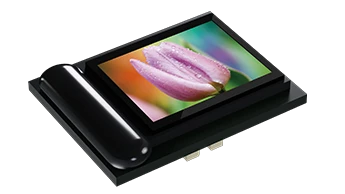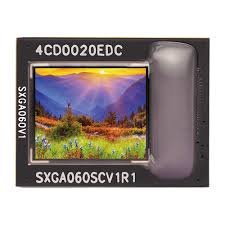When you hear the word micro display, think of a very small screen that does a big job. These tiny screens are used in many devices like smart glasses, VR headsets, military scopes, medical tools, and digital cameras. Even though they are small, micro displays can show sharp images, work fast, and stay bright. That’s why they are used where space is tight but good picture quality is important.
As more gadgets become smaller and wearable, micro displays are becoming more popular. Big tech companies like Sony and BOE are building better and more powerful versions, like micro OLED and microLED. If you build products, work with electronics, or just like learning about new tech, it helps to know how these displays work and where they are used..
Micro Display Guide to Types, Features, and Common Uses
In this guide, we will explain the types of micro displays, their main features, and how they are used in real life.
What Is a Micro Display?

A micro display is a very small screen used to show video or images in compact devices. These displays are usually less than 1 inch in size, making them ideal for products that don’t have much room for large screens. They can show high-quality visuals even in small spaces.
Micro displays are often used in devices like smart glasses, virtual reality headsets, digital viewfinders, night vision goggles, and medical tools. Instead of looking directly at the screen, people usually view micro displays through a lens or optical system that enlarges the image.
There are different kinds of micro displays based on how they create and show images. Some use light from behind (like LCDs), some reflect light (like LCoS), and some light up on their own (like OLED and MicroLED). Each type is built for specific needs depending on the product’s design, size, power needs, and clarity.
Micro displays are not meant for use like TVs or phones. They are for devices where space is small but sharp image quality is needed.
Types of Micro Displays
There are several types of micro displays. Each type has different technology behind it. These types are chosen depending on what the device needs — such as low power use, high resolution, or bright light performance.
1. LCD (Liquid Crystal Display)
LCD micro displays use a backlight and liquid crystals to control the image. The light passes through filters and crystals to form colors and shapes.
Pros
- Affordable to produce
- Reliable with long use
- Easy to find
Cons
- Needs a backlight
- Lower contrast
- Not as thin as OLED
2. LCoS (Liquid Crystal on Silicon)
LCoS uses liquid crystals on a reflective silicon base. It reflects light instead of letting it pass through.
Pros
- High image quality
- Sharp resolution
- Better colors than basic LCD
Cons
- Needs extra light source
- Slightly larger in size
- Slower refresh rates
3. OLED (Organic Light Emitting Diode)
OLED displays do not need a backlight. Each pixel creates its own light, giving better color and deeper black levels.
Pros
- Very high contrast
- Thin and lightweight
- Fast image changes
Cons
- Expensive to make
- May wear out over time
4. Micro OLED
Micro OLED is a smaller version of OLED built on a silicon base. It combines the benefits of OLED with very small size and high resolution.
Pros
- Ultra-clear image
- Low power use
- Very compact
Cons
- High cost
- Harder to produce
5. MicroLED
MicroLED is a newer technology where each pixel is a tiny LED. It lights up on its own like OLED but lasts longer and is even brighter.
Pros
- Very bright
- Very low power use
- Long life
Cons
- Still in development
- High production cost
Comparison Table: Types of Micro Displays
| Type | Size | Contrast | Brightness | Power Use | Cost | Usage Area |
|---|---|---|---|---|---|---|
| LCD | Small | Low | Medium | Medium | Low | Cameras, scopes |
| LCoS | Small | Medium | Medium | Medium | Medium | AR glasses, projectors |
| OLED | Very Small | High | High | Low | High | VR headsets |
| Micro OLED | Tiny | Very High | High | Very Low | High | Wearables, optics |
| MicroLED | Tiny | High | Very High | Very Low | Very High | Future AR/VR |
Key Features of Micro Display

Micro displays are selected based on their features. These include resolution, brightness, contrast, speed, and power use. Each feature affects how the display performs inside a product.
1. Resolution
Resolution is the number of pixels on the screen. Higher resolution means a clearer and more detailed image.
- Low: 640 x 480 (VGA)
- Medium: 1280 x 720 (HD)
- High: 1920 x 1080 (Full HD)
- Very High: 3840 x 2160 (4K)
Micro OLED and LCoS displays often support very high resolution in small size.
2. Brightness
Brightness is how much light the display gives. It is measured in nits. Brightness is important for devices used outdoors or in sunlight.
- Low: 200 to 400 nits (indoor use)
- Medium: 500 to 800 nits (general use)
- High: 1000+ nits (outdoor/AR)
MicroLED displays have very high brightness.
3. Contrast Ratio
Contrast is the difference between the darkest black and the brightest white. Higher contrast gives a better picture.
- LCD: Low contrast
- LCoS: Medium contrast
- OLED/Micro OLED: Very high contrast
4. Response Time
Response time means how fast the display can change from one image to another. It is important for video and motion.
- Fast: Under 1 millisecond (OLED, Micro OLED)
- Medium: 1 to 5 ms (LCoS)
- Slow: 10+ ms (LCD)
Fast response avoids motion blur and lag in AR/VR.
5. Power Consumption
Lower power use is needed for portable or wearable devices. Micro OLED and MicroLED are best for this.
| Feature | Ideal Display Type |
|---|---|
| High Resolution | Micro OLED, LCoS |
| High Brightness | MicroLED |
| Fast Response | OLED, Micro OLED |
| Low Power Use | Micro OLED, MicroLED |
| Affordable Price | LCD |
Common Uses of Micro Displays
Micro displays are used in many industries. Here are the main areas where they are most common:
1. Smart Glasses
Micro displays are built into smart glasses to show digital info close to the user’s eye. LCoS and Micro OLED are often used.
2. Virtual Reality (VR) Headsets
VR headsets use displays with high resolution and fast response time. OLED and Micro OLED work best here.
3. Augmented Reality (AR) Devices
AR devices need bright and clear displays to show images over the real world. MicroLED and LCoS are good for this.
4. Digital Cameras
Electronic viewfinders in digital cameras use micro displays to let users see exactly what they are shooting. LCD and Micro OLED are often used.
5. Medical Tools
Some medical goggles and wearable screens use micro displays to show scans, data, or video during operations.
6. Industrial Wearables
Factory workers and technicians wear smart helmets and glasses with built-in micro displays to help them see instructions or part numbers.
7. Military Equipment
Night vision goggles and scopes use micro OLED displays for clear vision in the dark without using much power.
Advantages of Micro Displays
Micro displays offer several benefits that make them useful in small and wearable electronics.
1. Compact Size
They take up very little space, making them easy to place inside glasses, goggles, and small tools.
2. Lightweight
Most micro displays are very light, which helps keep devices comfortable to wear or carry.
3. High Image Quality
Despite being small, they can show high-resolution and sharp images.
4. Low Power Use
Some types, like Micro OLED and MicroLED, use very little battery. This is good for wearable or mobile devices.
5. Fast Image Change
They can update images quickly, which is important in VR and gaming where motion is involved.
Limitations of Micro Displays
While useful, micro displays also have some downsides:
- High cost for advanced types (like Micro OLED or MicroLED)
- Not usable as stand-alone screens without optics
- May need careful alignment for viewing
- Limited production for newer types like Micro LED
Bottom Line
Micro displays may be small in size, but they play a big role in today’s smart and compact devices. From smart glasses and VR headsets to cameras, medical tools, and military equipment, these tiny screens help deliver clear visuals where regular displays can’t fit. They offer features like high resolution, fast response, low power use, and excellent image quality.
There are different types of micro displays such as LCD, LCoS, OLED, Micro OLED, and MicroLED. Each type is made for specific needs — some are better for bright outdoor use, others for high-speed video or long battery life. Knowing the features and uses of each type can help you choose the right display for your product or application.
As technology moves toward smaller and smarter designs, micro displays will continue to grow in importance. They are a key part of the future of wearables, AR/VR, and mobile tools. Whether you are building a device or just learning about display technology, understanding micro displays will help you stay ahead.
Use this guide as a reference when comparing options, and make sure to match the display type with your project’s specific needs.
FAQs:
What is the size of a micro display?
Most micro displays are under 1 inch diagonal. Some are as small as 0.2 inch.
Can micro displays show Full HD?
Yes. Micro OLED and LCoS displays can show Full HD and even 4K resolution in small formats.
Are micro displays good for bright areas?
Some are. MicroLED and high-brightness LCoS displays work well in outdoor or daylight conditions.
Do micro displays use a lot of power?
No. Most use very low power, especially Micro OLED and MicroLED, which are ideal for battery-powered devices.
Are micro displays the same as small screens?
Not exactly. They are small but built differently for special use cases. They often need a lens to view properly and are used inside devices.

